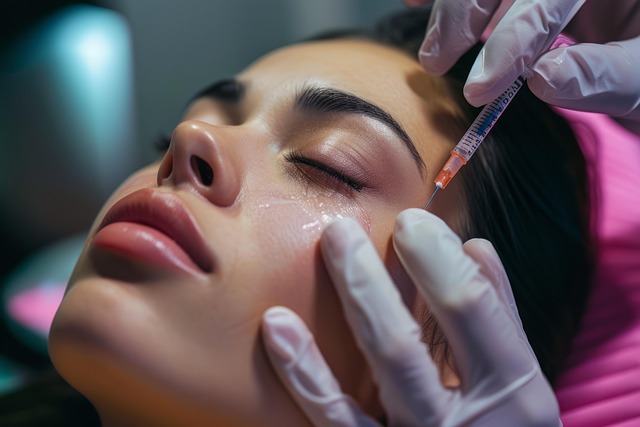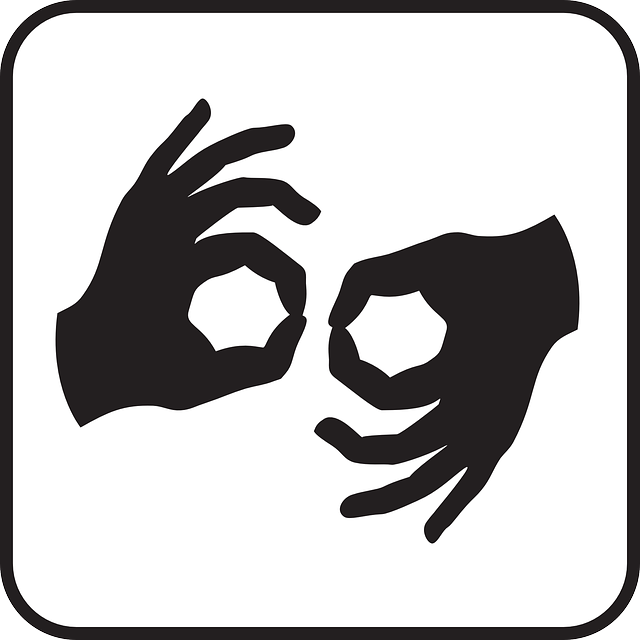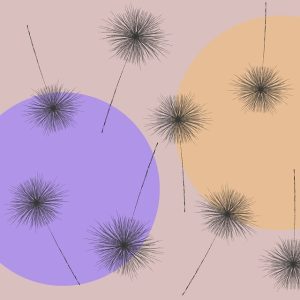Botox injections are a popular, non-surgical treatment for minimizing fine lines and wrinkles on the forehead. Caused by muscle movement, sun exposure, aging, and genetics, these wrinkles can be dynamic (expression) or static. Botox paralyzes muscles responsible for wrinkle formation, smoothing skin and enhancing youthfulness. With minimal downtime, results last 3-6 months, requiring repeat injections every 3-4 months. Personalized dosing, proper aftercare, and combined with other anti-aging techniques maximize results while minimizing side effects.
“Uncover the secrets to a smoother, younger-looking forehead with our comprehensive guide to Forehead Line Reduction. We explore the science behind Botox and its remarkable ability to combat fine lines and wrinkles non-surgically. Learn about various causes and types of forehead creases, understand how Botox works its magic, and discover the benefits of this popular anti-aging treatment. From personalized dose selection to post-treatment care and maintenance tips, we’ve got you covered. Uncover the transformative power of Botox for fine lines and wrinkles, leaving your skin rejuvenated and confident.”
Understanding Forehead Lines and Wrinkles: Causes and Types

Forehead lines and wrinkles are a common concern for many, especially as we age. These facial features can range from subtle expression lines to deep, etched creases, significantly impacting one’s appearance. Understanding their causes and types is essential when considering treatments like Botox for fine lines and wrinkles.
Various factors contribute to the formation of forehead lines, including muscle movement, sun exposure, aging, and genetics. Expression lines, often seen as a result of frequent frowning or raising of the eyebrows, are dynamic wrinkles that form due to repeated muscle contractions. Static wrinkles, on the other hand, are permanent folds in the skin caused by underlying structural changes. Both types can be addressed with Botox injections, which work by temporarily paralyzing the muscles responsible for wrinkle formation, thereby smoothing out the skin’s surface.
The Role of Botox in Reducing Fine Lines

Botox has emerged as a popular and effective treatment for reducing fine lines and wrinkles, particularly on the forehead. It works by relaxing the muscles that cause creases and frowns, thereby smoothing out the skin’s surface. When injected by a trained professional, Botox can significantly lessen the appearance of age-related or expression-induced wrinkles, offering a non-surgical alternative to more invasive procedures.
This cosmetic treatment has gained widespread acceptance due to its minimal downtime and long-lasting results. By targeting specific muscle groups, Botox can prevent dynamic wrinkle formation, allowing for a more youthful and refined forehead contour. Its ability to temporarily paralyze muscles makes it an excellent choice for those seeking subtle enhancements without losing natural expression.
How Botox Works to Smoothen the Forehead

Botox has emerged as a popular and effective non-surgical treatment for reducing fine lines and wrinkles, including those prominent on the forehead. The procedure involves injecting a small amount of botulinum toxin into specific muscle groups responsible for causing dynamic wrinkles. This potent neurotoxin temporarily paralyses the muscles, preventing them from contracting and thus minimising the appearance of wrinkles.
When used for forehead line reduction, Botox smoothes out the skin by relaxing the frontal fibral rhythm, which is responsible for the constant small movements that contribute to the formation of expression lines. By blocking these contractions, Botox allows the skin to appear smoother and more youthful. This procedure offers a non-invasive approach to beauty enhancement, providing results that can last from 3 to 6 months, depending on individual factors.
Benefits of Non-Surgical Forehead Rejuvenation with Botox

Non-surgical forehead rejuvenation using Botox has gained significant popularity due to its numerous advantages. One of the key benefits is its ability to effectively reduce the appearance of fine lines and wrinkles on the forehead, a common area where aging can be most noticeable. By injecting small amounts of Botox into specific muscle groups, practitioners can relax these muscles, preventing them from contracting and causing creases in the skin. This non-invasive procedure offers a quick and relatively painless way to achieve a younger-looking forehead without the need for extensive surgery or downtime.
Additionally, Botox treatments provide a natural and subtle enhancement, allowing individuals to maintain a youthful appearance while still recognizing their unique features. It is particularly appealing to those who want to delay the signs of aging or address existing wrinkles without drastic measures. The results of Botox for fine lines and wrinkles on the forehead are often immediate, providing a temporary yet significant improvement that can last for several months, making it an attractive option for individuals seeking a more youthful complexion.
Choosing the Right Dose: Personalizing Your Treatment Plan

When considering Botox for fine lines and wrinkles, one of the most critical aspects of your treatment plan is choosing the right dose. This highly personalized approach ensures optimal results with minimal side effects. The concentration and quantity of Botox injected depend on several factors unique to each individual, including skin thickness, muscle activity, age, and the severity of wrinkles. A qualified dermatologist will assess these elements to determine the suitable dose for your forehead lines reduction treatment.
Personalizing your treatment plan allows for precise targeting of problem areas while avoiding unnecessary injection in less affected zones. This tailored approach maximizes the benefits of Botox, smoothing out fine lines and wrinkles without altering facial expressions or causing discomfort. By working closely with a specialist, you can achieve natural-looking results that enhance your overall appearance.
What to Expect During and After Botox Injection for Forehead

When undergoing Botox injections for forehead lines, it’s crucial to understand what to expect both during and after the procedure. During the treatment, a healthcare professional will inject small amounts of Botox into specific muscles on your forehead. You may feel slight discomfort or a pinching sensation at each injection site, but most providers use topical anesthetics to minimise any pain. The process is quick, usually taking around 15-30 minutes, and you can resume your normal activities immediately afterwards.
After the Botox injection for fine lines and wrinkles on the forehead, it’s common to experience temporary swelling or bruising at the injection sites. This usually subsides within a few days. You may also notice a slight change in facial symmetry right after the treatment, but this is temporary as the Botox takes effect. It typically starts showing results within 2-4 days, with the full effect visible after about a week. It’s essential to follow your provider’s aftercare instructions, which may include avoiding strenuous activities and certain medications for a few days to ensure optimal healing.
Potential Side Effects and Management

While Botox for fine lines and wrinkles is a popular choice for forehead line reduction, like any medical procedure, it’s not without potential side effects. Temporary redness, swelling, or bruising at the injection site are common, and resolution usually occurs within a few days. In rare cases, patients may experience headaches, dizziness, or eye issues.
To manage these side effects, it’s crucial to follow your healthcare provider’s instructions carefully post-treatment, including avoiding strenuous activities and specific medications for a period advised by your doctor. Applying cold compresses can help reduce swelling and bruising, while over-the-counter pain relievers may alleviate any discomfort. Most side effects are temporary, and with proper management, you can enjoy the benefits of a smoother forehead without significant lasting issues.
Maintenance and Frequency of Botox Treatments for Long-Lasting Results

To maintain the reduced appearance of forehead lines and wrinkles treated with Botox, ongoing treatment is necessary. The frequency of these treatments varies based on individual skin aging factors and lifestyle. Generally, most people require a repeat Botox injection every 3 to 4 months to preserve the results. This maintenance schedule helps replace the naturally occurring Botulinum Toxin in the body, which usually lasts about 3-6 months.
Proper skincare between treatments is crucial for long-lasting results. Using moisturizers, avoiding excessive sun exposure, and maintaining a healthy diet can all contribute to minimizing new wrinkle formation. Additionally, understanding that genetics play a significant role in skin aging means that consistent care and realistic expectations are essential when considering Botox for fine lines and wrinkles.
Combining Botox with Other Anti-Aging Techniques

When considering forehead line reduction, many individuals opt for a multi-faceted approach to achieve youthful-looking skin. Combining Botox for fine lines and wrinkles with other anti-aging techniques can offer comprehensive results. Microdermabrasion, for instance, helps exfoliate the skin, improving texture and enhancing the penetration of Botox treatments. Similarly, chemical peels can remove dead skin cells, revealing smoother, more even skin that responds better to Botox injections.
Additionally, incorporating topical antioxidants and moisturizers into your skincare routine can protect the skin from environmental damage while supporting the effects of Botox. These techniques work synergistically to minimize forehead lines and wrinkles, providing a more pronounced and lasting reduction in facial signs of aging.
